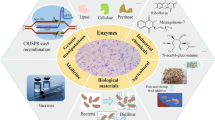Abstract
Heavy-ion beams, possessing a wide mutation spectrum and increased mutation frequency, have been used effectively as a breeding method. In this study, the heavy-ion beams generated by the Heavy-Ion Research Facility in Lanzhou were used to mutagenize Aspergillus terreus CA99 for screening high-yield lovastatin strains. Furthermore, the main growth conditions as well as the influences of carbon and nitrogen sources on the growth and the lovastatin production of the mutant and the original strains were investigated comparatively. The spores of A. terreus CA99 were irradiated by 15, 20, 25, and 30 Gy of 80 MeV/u 12C6+ heavy-ion beams. Based on the lovastatin contents in the fermentation broth, a strain designated as A. terreus Z15-7 has been selected from the clone irradiated by the heavy-ion beam. When compared with the original strain, the content of lovastatin in the fermentation broth of A. terreus Z15-7 increased 4-fold. Moreover, A. terreus Z15-7 efficiently used the carbon and nitrogen sources for the growth and production of lovastatin when compared to the original strain. The maximum yield of lovastatin, 916.7 μg/ml, was obtained as A. terreus Z15-7 was submerged cultured in the chemically defined medium supplemented with 3% glycerol as a carbon source, 1% corn meal as an organic nitrogen source, and 0.2% sodium nitrate as an inorganic nitrogen source at 30 °C in the shake flask. The result shows that heavy-ion beam irradiation is an effective method for the mutation breeding of lovastatin production of A. terreus.






Similar content being viewed by others
References
Li, Q. (2007). Advances in Space Research, 40, 455–460.
Kikuchi, S., Saito, Y., Ryuto, H., Fukunishi, N., Abe, T., Tanaka, H., et al. (2009). Mutation Research, 669, 63–66.
Shikazono, N., Suzuki, C., Kitamura, S., Watanabe, H., Tano, S., & Tanaka, A. (2005). Journal of Experimental Botany, 56, 587–596.
Zhang, M., Liang, S., Hang, X., Xiang, Y., Cheng, Z., Li, W., et al. (2011). Advances in Space Research, 47, 1054–1061.
Matuo, Y., Nishijima, S., Hase, Y., Sakamoto, A., Tanaka, A., & Shimizu, K. (2006). Mutation Research, 602, 7–13.
Gu, S. B., Li, S. C., Feng, H. Y., Wu, Y., & Yu, Z. L. (2008). Applied Microbiology and Biotechnology, 78, 201–209.
Endo, A. (1979). Journal of Antibiotics, 32, 852–854.
Alberts, A. W., Chen, J., Kuron, G., Hunt, V., Huff, J., Hoffman, C., et al. (1980). Proceedings of National Academy of Sciences of the United States of America, 77, 3957–3961.
Frishman, W. H., Zimetbaum, P., & Nadelmann, J. (1989). Journal of Clinical Pharmacology, 29, 975–982.
Manzoni, M., & Rollini, M. (2002). Applied Microbiology and Biotechnology, 58, 555–564.
Barrios-González, J., & Miranda, R. U. (2010). Applied Microbiology and Biotechnology, 85, 869–883.
Endo, A., Kuroda, M., & Tsujita, Y. (1976). Journal of Antibiotics, 29, 1346–1348.
Kumar, M. S., Jana, S. K., Senthil, V., Shashanka, V., Kumar, S. V., & Sadhukhan, A. K. (2000). Process Biochemistry, 36, 363–368.
Casas López, J. L., Sánchez Pérez, J. A., Fernández Sevilla, J. M., Acién Fernández, F. G., Molina Grima, E., & Chisti, Y. (2003). Enzyme and Microbial Technology, 33, 270–277.
Lai, L. S. T., Pan, C. C., & Tzeng, B. K. (2003). Process Biochemistry, 38, 1317–1326.
Manzoni, M., Bergomi, S., Rollini, M., & Cavazzoni, V. (1999). Biotechnology Letters, 21, 253–257.
Hajjaj, H., Niederberger, P., & Duboc, P. (2001). Applied and Environmental Microbiology, 67, 2596–2602.
Jia, Z., Zhang, X., & Cao, X. (2009). Asia-Pacific Journal of Chemical Engineering, 4, 672–677.
Miyake, T., Uchitomi, K., Zhang, M. Y., Kono, I., Nozaki, N., Sammoto, H., et al. (2006). Bioscience, Biotechnology, and Biochemistry, 70, 1154–1159.
Wen, J., Gu, X. L., Chang, P., & Jing, Z. L. (2000). China Food Additives, 4, 11–17.
Lai, L. S., Hung, C. S., & Lo, C. C. (2007). Journal of Bioscience and Bioengineering, 104, 9–13.
Panda, B. P., Javed, S., & Ali, M. (2009). Biotechnology and Bioprocess Engineering, 14, 123–127.
Sorrentino, F., Roy, I., & Keshavarz, T. (2010). Applied Microbiology and Biotechnology, 88, 65–73.
Palego, L., Giannaccini, G., Saccomanni, G., Rossi, A., Lucchesi, V., Mascia, G., et al. (2010). Chromatographia, 71, 291–297.
Acknowledgment
This work was supported by the National Natural Science Foundation of China (30960063).
Author information
Authors and Affiliations
Corresponding author
Rights and permissions
About this article
Cite this article
Li, SW., Li, M., Song, HP. et al. Induction of a High-Yield Lovastatin Mutant of Aspergillus terreus by 12C6+ Heavy-Ion Beam Irradiation and the Influence of Culture Conditions on Lovastatin Production Under Submerged Fermentation. Appl Biochem Biotechnol 165, 913–925 (2011). https://doi.org/10.1007/s12010-011-9308-x
Received:
Accepted:
Published:
Issue Date:
DOI: https://doi.org/10.1007/s12010-011-9308-x




